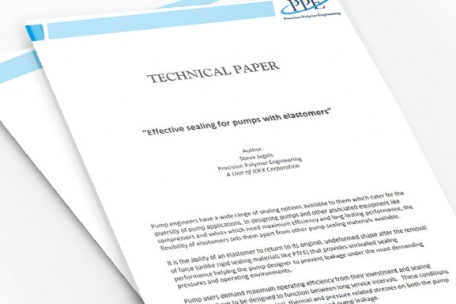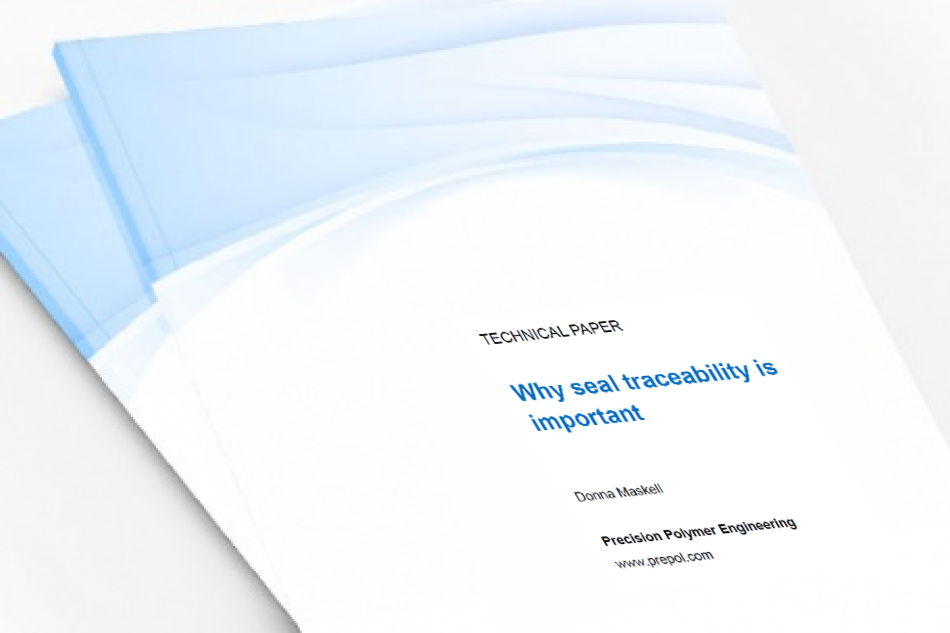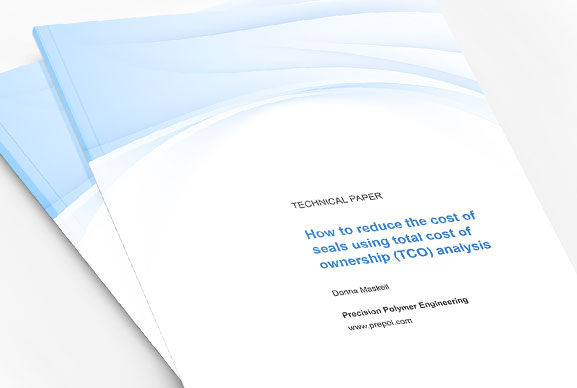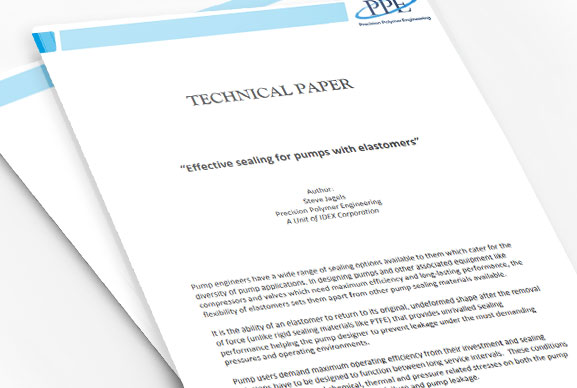White Papers
PPE is a regular contributor to articles in trade publications and our sealing specialists present technical papers at conferences and seminars around the world. Here we have gathered together some of the most popular topics from various industries in a series of white papers.
Whitepapers - Semiconductor

Electrostatic Discharge in Semiconductor
Technological progress within the semiconductor industry brings with it greater yield sensitivity with the desire to reduce costs a constant driver. How well defects are controlled throughout an increasingly automated manufacturing process plays a critical role.

Killer Consumables: How clean are your seals?
In semiconductor manufacturing the threat of particle and especially metallic contamination to transistor integrity is a significant and potentially costly threat. This is mainly true for front end processing but, due to the high mobility of many of these contaminants, it remains a threat at all stages of the manufacturing process flow. TP00115

Purity or Plasma Resistance - Can you have both?
A study of tests carried out on different elastomer materials in aggressive chemistries and plasma conditions. Various plasma modes were employed, reflecting a variety of different process requirements. This included direct parallel plate, high density remote inductively coupled plasma (ICP) and sources specifically designed to create high radical and in particular, high fluorine radical content. TP00116

Introduction to Perlast Helios
Perlast® Helios G7HA is a perfluoroelastomer (FFKM) material capable of eliminating the trade-off betweeen high purity, plasma resistance and high temperature performance when exposed to 300°C and above, in semiconductor manufacturing. TP00117
Whitepapers - Oil & Gas

Choosing a High Temperature Steam Resistant Elastomer
There are limited options for sealing with elastomers in hot water or steam environments in temperatures up to 550°F (288°C). Most elastomers in will become brittle and crack, resulting in leakage from a valve, pump or other equipment. Leakage resulting from a cracked seal can create hazardous conditions, unnecessary downtime, and equipment failure.
This paper details the properties of EnDura® E90SR after high temperature steam exposure in comparison with other types of commercially available elastomers.

Low Temperature Sealing in High Pressure Applications
There are many choices in elastomer materials based on criteria such as chemical and heat resistance. Often the low temperature performance of an elastomer is overlooked or the data describing the performance may not be understood fully by the end user. Complicating elastomer material selection is the pressure of the application. High pressures are known to increase an elastomer’s glass transition temperature which decreases the low temperature sealing performance.

API 6A/ISO 10423 Appendix F.1.13.5.2 Elastomer Immersion Tests
API 6A/ISO 10423 Appendix F.1.13.5.2 Elastomer Immersion Tests are common benchmarks for elastomeric sealing materials being used in the oil and gas industry. This document summarises the test requirements of the API 6A, Annex F and ISO10423 Elastomer Immersion Tests and highlights areas to be considered when interpreting results.
Whitepapers - Food, dairy and beverage

Elastomers for CIP and SIP operations
Clean-in-place (CIP) operations are used to clean and sterilize surfaces in a manufacturing facility without the need to disassemble large components or manufacturing equipment.
Gaskets, O-rings, sanitary rings, hygienic pipe connectors and other elastomer seals are commonly used to prevent leaks in these systems. To ensure a long service life, these seals must be resistant to chemical attack from any cleaners that are used during CIP, plus high temperatures and pressures experienced under SIP.
This whitepaper looks at which elastomers are best for CIP and SIP operations.

Why seal traceability is important
Traceability is an essential consideration when specifying seals, ensuring reduced variation in production processes and mitigating the risk of allowing counterfeit materials into your supply chain.
This whitepaper looks at the risks involved with poor traceability of sealing materials and components. It investigates the problems that can occur using counterfeit components and gaskets that are not what they claim to be, and provides examples of hygienic gaskets purchased online.
It makes recommendations on how users can safeguard their operations when purchasing seals and gaskets.

Understanding the differences between FKM and FFKM elastomers
This whitepaper discusses the fundamentals of FKM and FFKM materials, investigates their strengths and weaknesses and the impact on their suitability for use in the most critical sealing applications.

Elastomer sealing, SIP and CIP - what you should know
This whitepaper investigates the best elastomer sealing materials for Steam In Place (SIP) and Clean In Place (CIP) processes and looks at some of the challenges seen in these applications.

FDA compliance for elastomers - what do I need to know?
Elastomers seals used in food and pharmaceutical manufacturing must be compliant with a range of legislative regulations and hygiene standards, FDA is often a core requirement. This whitepaper looks at how materials are tested and the different levels of FDA compliance - not all seals are equal.

How to reduce the cost of seals using TCO
The drive to reduce the cost of consumables, such as seals, is a constant pressure. Companies are continually looking to reduce costs in order to maintain or increase profitability in challenging economic conditions. Often, the cost of the seal is the tip of the iceberg, this is the direct cost, but there are lots more hidden costs that are not as obvious. Total Cost of Ownership (TCO) analysis can be used to look at all the costs associated with buying and using a particular seal compared with alternatives. TP00120

The Case for FFKM Sealing in Life Science Applications
Why are FFKM elastomer materials so well suited for life science applications? This whitepaper explains the benefits of FFKM, how it compares to other elastomer materials and why it is becoming the material of choice for many food, dairy and pharmaceutical sealing applications. TP00118

7 Causes of Sanitary Clamp Gasket Failure and How to Eliminate Them
Within the food, beverage and pharmaceutical processing industries sanitary clamp fittings (such as Tri-clamp™ and Tri-clover™) are essential for joining sections of pipework. Sanitary gaskets provide the sealing function in these clamp fittings, but when things go wrong and failure occurs, this can result in leakage, contamination, lost production and costly downtime. This article looks at some of the most common reasons for sanitary gasket failure.

How to Measure and Specify the Correct Tri-Clamp® Sanitary Gasket
Sanitary fittings are an essential part of process pipework that is used in many food, beverage, and pharmaceutical plants. To achieve efficient sealing, the perfect sized gasket must be selected, and this is where things can become tricky. Differences in clamp standards around the world and incorrect measuring of fittings can result in the wrong gaskets being used, which leads to leakage, contamination and costly downtime.

Why You Should Rethink Your PTFE/Teflon® Tri-clamp® Sanitary Gaskets
Polytetrafluoroethylene, better known as PTFE, or by its brand name Teflon®, is commonly used as a sanitary gasket in pipe connectors within process lines. PTFE gaskets are often used in demanding sanitary environments where traditional elastomers such as EPDM, NBR and Silicone are not suitable. But if your PTFE gaskets are failing, causing downtime and disruption, what can you do?
Whitepapers - General

Types of Fluoroelastomer Seals for Pump Users: Explained
Aggressive pumping environments can be problematic for pump engineers. On the one hand it's impossible to design the pump to be resistant to every kind of chemical, while on the other, the tendency is to either over specify a perfluoroelastomer to cover all eventualities or select an elastomer with mid-range chemical resistance in the hope this will cover most applications. This paper investigates the latest developments in fluoroelastomer technology.

Effective Sealing for Pumps with Elastomers
Pump users demand maximum operating efficiency from their investment and sealing solutions have to be designed to function between long service intervals. These conditions often create increased chemical, thermal and pressure related stresses on both the pump and seals, multiplying the risk of seal failure and pump leakage.